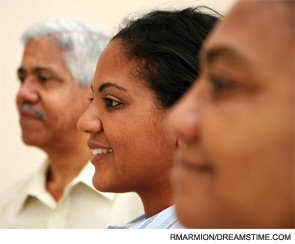
It is well known that systemic lupus erythematosus (SLE) disproportionately affects women and members of racial and ethnic minorities, and that persons with SLE of lower socioeconomic status have poorer outcomes of disease and higher death rates. The combination of SLE’s increased prevalence among minorities and women and its complexity, which leads to a need to have access to a wide range of healthcare services, makes SLE an important case study of how people of a racial or ethnic minority or another group facing discrimination or disadvantaged due to having low incomes fare in the U.S. healthcare system.
Researchers have long known that women and members of several racial and ethnic minorities have higher rates of SLE, particularly African-Americans, Asian-Americans, Native Americans, and Hispanics. Recent research has begun to identify genes and environmental triggers that may partially explain these differences.
After diagnosis, the course of the SLE depends on many of the same factors that appear to contribute to the development of SLE in the first place. Evidence implicates genetic make-up, race/ethnicity, and socioeconomic status, particularly living in poverty. The persistence of differences in course of disease based on race/ethnicity and socioeconomic status has given rise to an increasing number of studies to help explain why such disparities exist. These studies have in turn led to efforts such as The Lupus Initiative, which is designed to reduce disparities in SLE outcomes. [See this month’s “President’s Perspective” for more on The Lupus Initiative.]
Several studies have attempted to discover whether the genetic aspects of race or the social aspects, such as being subjected to discrimination and having disproportionate poverty rates, accounts for the poor outcomes of minority groups.
The nature of our healthcare system probably also plays a role in the outcomes of vulnerable groups (more on why below). However, it clearly is not responsible for all of the effects of being a woman, member of a racial minority, or being in an economically disadvantaged position. We know this because in developed countries with universal health insurance coverage and good health systems, some of the same effects of gender, race/ethnicity, and poverty are seen—although it could be that the quality of care may not be optimal in any country, especially when it comes to treating vulnerable populations. In the U.S., many at-risk patients have access to insurance and the same experienced physicians and hospitals as more advantaged populations, yet still experience poorer outcomes.
What, aside from access to good healthcare, could account for the impact of race/ethnicity and low socioeconomic status on outcomes? Having more stressful living conditions and fewer resources to deal with the stress may play a role. Like many autoimmune conditions, stress may increase disease activity and prolong flares in SLE; one source of stress may be not having any employment or having only marginal and episodic work. Persons with lower levels of education may also have a more difficult time managing the disease through a combination of self-management and gaining access to patient groups and to more experienced healthcare providers.
One study points to a mechanism to explain how poverty affects outcomes. That study demonstrated separate effects of being in poverty oneself and of living in areas of concentrated poverty (typically ghettos) on a range of lupus measures, including activity, symptoms, functional status, and depression. The combined effect of being poor and living in an area of concentrated poverty profoundly increased depression rates among persons with SLE.1 This suggests a model of “stress overload” of having few personal resources in a situation with SLE that demands many, while also living in communities in which the ambient stress level is high and resources, including healthcare providers, few.
Recently, an article appeared describing the ideal features of healthcare for persons with conditions like SLE that are complex, chronic, and have diverse comorbidities. The authors state that in the current system, “Treatment burdens are often imposed on patients with little coordination between, or even within, clinics dealing with different conditions and little explicit recognition that treatment regimens are demanding in time and effort.”2 The effects are likely to be heightened for persons with limited capacity due to background and/or compromised cognitive function, especially with respect to coordination of care among providers. It is also clear that the transition from pediatric to adult care is often difficult both because young adults do not generally have to focus on organizing their own care and because many this age do not have access to health insurance.
The care for disadvantaged persons with SLE may be the best example of how healthcare often fails the vulnerable in society. There is much evidence that outcomes are better for hospitals, clinics, and individual physicians with more experience in caring for this condition, but for many reasons the disadvantaged may not have good access to these providers. The disadvantaged with SLE are also disproportionately covered by Medicaid, but many providers do not accept Medicaid patients, forcing such persons to travel long distances for care. Some studies indicate that where one lives affects the kinds and amounts of healthcare received for SLE; many if not most of the disadvantaged live in communities without experienced providers. Even among the privately insured, there may be access problems as certain kinds of managed care plans limit healthcare to small panels of providers without needed expertise in SLE care. Some providers may exacerbate the difficulties faced by persons with SLE trying to organize their care because of communication styles that do not take into account their literacy levels or their ability to comprehend information given impairment in cognitive function. Language differences between patients and physicians may exacerbate the communication issues.
It is often said that, despite the high number of uninsured in the U.S., ultimately people get the care they need. Sadly, even in a severe disease like SLE, that is not necessarily the case. A study recently presented in two abstracts at the Annual Meeting of the ACR showed that in basic indicators of the quality of SLE care, there were systematic differences in quality on the basis of the kind of insurance one had and, worse, the proportion receiving care consistent with the indicators was substantially lower among those without insurance compared even to the worst group with insurance.3 The specialty of the main SLE physician also mattered in the quality of care received.
Putting It All Together
Research addressing why women and members of racial and ethnic minorities have higher rates of SLE and then do more poorly after diagnosis has made much progress over the last decade. Clearly, genetic predisposition plays a role in the onset of SLE, but so do the nature of economic disadvantage, the effects of racial and gender discrimination, the burdens of living in communities with high concentrations of the poor, and heightened exposure to environmental triggers of disease.
After onset, economic disadvantage plays an important role by limiting the resources, economic and otherwise, to deal with the cascade of medical needs, by heightening external stress in a stress-mediated disease, and by limiting access to the healthcare resources known to improve outcomes. The latter may include having providers with a lot of experience in the disease, having providers practiced at communicating effectively with those with complex diseases like SLE, having insurance and, when insured, having the kind of insurance which provides access to a broad range of experienced providers, and living in communities that lack such providers and also lack others who know how to find those providers. the rheumatologist
Dr. Yelin is adjunct professor, School of Medicine, Division of Occupational and Environmental Medicine at the University of California, San Francisco, and among the leadership of The Lupus Initiative.
References
- Trupin L, Tonner MC, Yazdany J, et al. The role of neighborhood and individual socioeconomic status in outcomes of systemic lupus erythematosus. J Rheum. 2008;35:1782-1788.
- May C, Montori VM, Mair FS. We need minimally disruptive medicine. BMJ. 2009;2011;339:b2803.
- Yazdany J, Trupin LS, Tonner C, et al. Quality of care in patients with systemic lupus erythematosus. Arthritis Rheum. 2010;62:(S10):2113.
- Yelin EH, Yazdany J, et al. The effect of health insurance and physician speciality on quality of care for SLE. Arthritis Rheum. 2010;62(S10):789.



